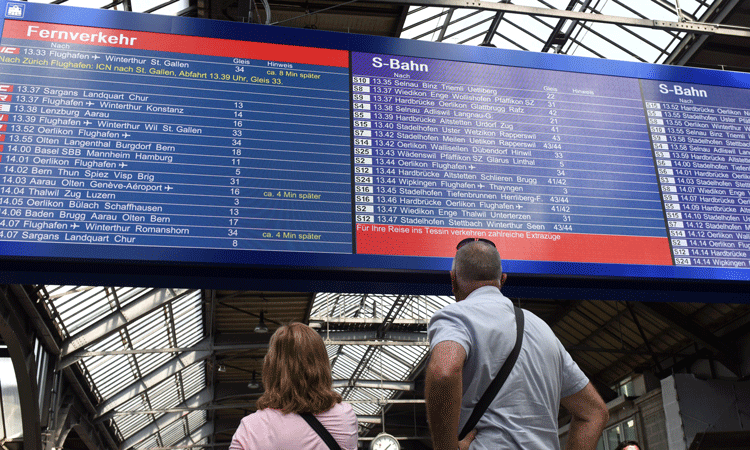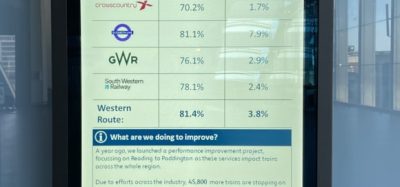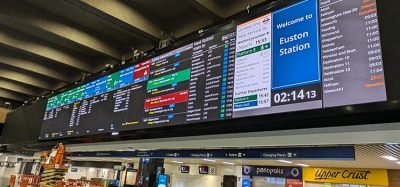From split-flap display to multimedia train information system
Posted: 6 August 2015 | | No comments yet
Who isn’t familiar with the big blue display information boards in Switzerland’s main train stations? At the time of the display installation more than 25 years ago, these units were the leading technology. Printed panels showed the train information for departing trains. Updating of the information caused the panels to rotate and fall into the desired position. This action caused its well-known sound, which will definitely be missed from the train station halls as technology is updated; the displays were starting to age and the service and warranty was running out, so SBB needed to search out new solutions. Project Manager at SBB, Lukas Spengeler, takes us through the project details and why modern LED displays have now been chosen.


Project scope
The project consists of 17 train stations with daily 1.3 million customers. That’s 17 aging display boards to be replaced with 44 modern displays at 17 different stations through Switzerland. The stations are located indoors and in covered outdoor areas, and therefore are subject to varying lighting, environmental conditions and temperatures. From Chur in the East to Geneva in the West, the new LED displays utilise the same technology and design, which saves costs in service and maintenance. Extreme wind and weather conditions in the Alpine region are paired with sophisticated design requirements in modern railway stations. Another special requirement is where multiple displays are installed, the train departure display and rail disruption display (showing advertising when no critical disruption news is shown), are used in a double combination fully redundant system. In Switzerland, the four national languages increases the solution complexity. The displays must be able to show all four languages, and the installations must be planned and documented in the local regional language.
Choice of technology
For more than one year, current technologies (LCD, projection, LED) were tested, compared and ranked. The technology decision was made in favour of LED display. The reasons:
- Excellent readability under any lighting conditions
- Modularity in sizes to meet the different needs of each station
- Representation of static content, changing images and video
- Seamless transitions between train information, disruption on the line announcements, customer information and other content
- Low power consumption and low maintenance costs
- Longevity and adaptability of content to future formats.
Comprehensive evaluation method
The high demands on reliability in railway operations were written in a public tender and in accordance with GATT guidelines made available to potential suppliers. The scope of the tender included:
- Production and delivery of the displays to each site
- Coordination and planning for the implementation of each location (meetings, inspections, etc.)
- Installation and commissioning of the displays
- Training for maintenance post installation and commissioning.
A general contractor for this challenging project was sought.
This search turned out to be challenging, as SBB required a 10-year full operation guarantee. This responsibility could only be entrusted to a well-established, experienced and financially strong manufacturer in the LED industry. This market is growing very quickly; many manufacturers come and go quickly. For a long-term thinking company like SBB and for the cycles which are common in the railway business, this environment is very unusual. Therefore extreme care had to be taken in selecting the right provider.
Schedule
The schedule was extremely demanding. From the time of tendering to end of realisation was only 19 months. Each location had to be carefully specified and planned in this period. The first pilot installation needed to be operational only 14 weeks after order.
Technical highlights
White text on blue background
SBB’s corporate blue colour is displayed as the background colour. The static blue background has an enormous influence on contrast, brightness and especially the lifetime of the installations.
A long operational life (after 70,000 hours with greater than 50% of original brightness) can be achieved under these conditions only with very good control techniques. The optimal design of the technology for indoor operation allows SBB to set a controlled base brightness of about 10% of the maximum possible brightness. The display adjusts the brightness with sensors to match ambient light conditions, and a predetermined reference curve automatically controls minimum and maximum brightness. An automatic correction of the colour values depending on the brightness of the image allows the display to visually appear the same day and night. This fully automatic setup has been specially refined by the supplier for this project and precisely adapted to the requirements of individual sites.
4mm pixel resolution
Daktronics 4mm indoor product utilises some of the best protective features to ensure long life. UV and humidity coating are essential as these semi-outdoor displays are used in a dusty and humid environment. Further protection is provided by the IP-67 connections linking all critical signal and power connections. The equipment must withstand these conditions without damage or malfunction over the years. Two annual cleanings for the front of the displays are anticipated; the cleaning will be made by the local train station operational staff.
Fully redundant switching; local and regional control
The multi-functional use and hot standby require an intelligent controller, which allows the content of one display to be shown upon another in case of failure. Forty-four Display Controllers will be in use to control the matching number of displays at the 17 train station locations.
Daktronics Inc. based in Brookings, SD USA, delivered the LED displays, installation and custom control interface for the project. Chief Software Developer Joe Schulte described the challenge to develop a complete control system solution: “Daktronics is accustom to working with real-time data in many of the markets we serve. We have interfaced with data from a number of different sources in a number of different methods. In this case we were tasked with accepting both data and control from a standard protocol defined by SBB. To achieve this we wrote a custom interface to translate the SBB protocol to Daktronics standard formats and protocols on the Daktronics DMP-8000 platform. This allowed us a large amount of flexibility to try to exactly match the customer’s expectations of presentation, timing, and error responses. We are able to render the exact fonts in the size and location desired and are able to show images exactly as specified. We have also added the ability to show HTML content on our displays for some exceptional messages.”
One important aspect of the system is the ability for the central control system office to dictate what information is shown on the display. A second department creates and displays content regarding rail line disruptions. Multiple live data and content sources can be sent to the displays from a head remote control headquarters.
Important for the maintenance of the display is the integration of the Daktronics error notification system IDM (Intelligent Device Management) and the SNMP traps used by SBB for automatic notification of a failure within the display system. Automatic notifications allow SBB to know what failure has occurred (loss of signal, defective cable, defective light sensor, etc.) and to quickly inform the first level service team on the steps to repair.
View from the Project Manager
The SBB display project is in the middle of its rollout. The first displays have been installed, and the results are extremely positive. The project challenges have been solved very well by a multifunctional team, led by the project management of Daktronics as General Contractor, the SBB project team, plus external experts. Initial customer feedback has proven we chose the right solution.
Interesting is also the business case which allows the Disruption/Delay Information Display to show advertising during times when train traffic is flowing normally. The high foot-traffic in Swiss train stations guarantees a high degree of interest from advertising agencies.
With this project, SBB has taken another visible step into the world of digital, multimedia information. In the next 10 years, additional functions such as interactivity or technological advances may be integrated site specific or Swiss-wide – just another step on our path to providing modern and active communication channels with our customers.
To keep up-to-date with the installation project and see the latest photos, please visit www.sbb.ch/generalanzeiger (in German only).
Biography
Lukas Spengeler works for the Infrastructure Division of the Swiss Federal Railways (SBB CFF FFS) as a Team Leader in construction and architecture. He is Project Manager of the modernisation of the so-called ‘general displays’ (German ‘Generalanzeiger’, or GA) in 16 Swiss stations. Lukas has a diploma in architecture from Hochschule Luzern as well as a Master of Advanced Studies in Business Administration from Fachhochschule Zentralschweiz. Before joining SBB, Lukas managed his own architecture office for six years.






